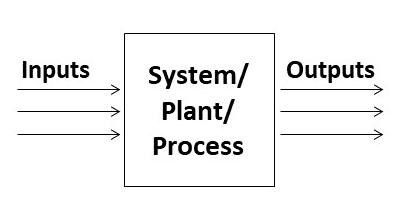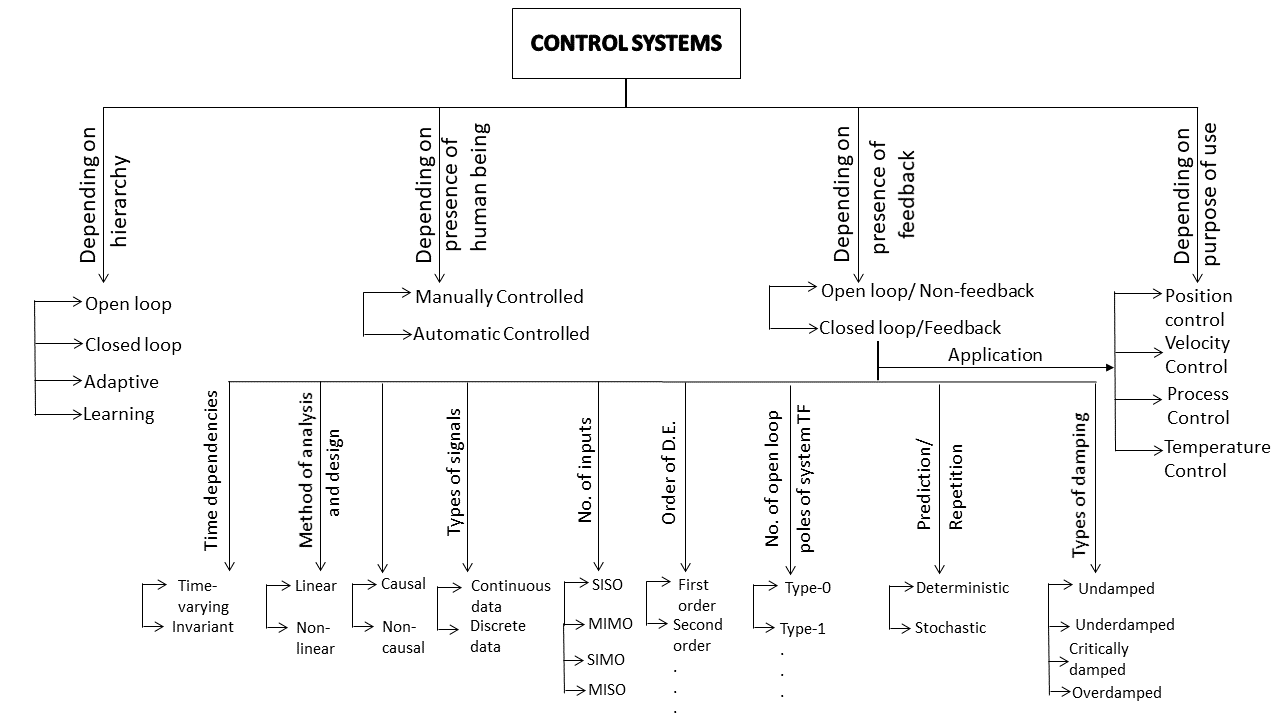Control Systems
Let’s have an overview about Control Systems. What is a control system? What is its definition? What is the significance of it? What are the requirements for a good control system? And what are the various types of control systems? In short, let’s have a brief, short and simple introduction to the basics of control systems.
What is Control System?
Let’s split these two words control and system and try to find out its respective explanation.
Control: Control can be defined as to regulate, direct or command something (here a system) so as that desired objective is attained. It is making a system to behave as desired, as we want as per the requirements.
System: System can be called as an entity to which inputs are given and outputs are obtained. More precisely, system is an arrangement of or combination of different physical components connected or related in such a manner so as to form an entire unit to attain a certain objective.

Schematic diagram of a system.
Therefore, a control system can be defined as the output quantity being controlled by the variation in the input quantity. Also, it is by means of which any quantity of interest in machines, mechanism or other equipment is maintained or altered in accordance with a desired manner. Here the quantity mentioned above can be any physical quantity like pressure, temperature, flow, level, etc. which needs to be measured.
Control systems as the name now suggests that are the systems which can be control and these are useful in automation i.e. making the manual operations semi-automatic or fully automatic by studying and analyzing them, by using various mathematical tools.
Now let’s have a look on the requirements for a good control system.
Requirement of good control systems:
· Must be high.
· Improved by using feedback element/closed loop.
· Error detector will increase the accuracy.
· Due to changes in output, due to environmental or parametric changes it is affected.
· Hence system must be insensitive to such parameters but sensitive to input.
· It is the unwanted signal, disturbance signal i.e. noise.
· Hence must be insensitive to the unwanted noise signal.
· It must be bounded input bounded output stable.
· Stable for all the variations.
· It must be large.
· Maximum output without overshoots and stable for required input frequency ranges.
· High speed so that the output is fast as possible.
· Must be constant or follow the Barkhuizen’s criteria.
· It must give the complete picture and answers to the system and its problem.
· Must not be complicated.
· Must be easy to understand and everyone should get a clear concept.
· It must be flexible and must operate and respond on every input.
· It must be cost effective.
· It must follow proper standards.
Significance of the Control Systems:
Whenever, whatever is needed to be made automatic, control system is needed. So, having knowledge about control systems can make it easy to make any operations which are manual into semi-automatic or fully automatic according to the requirements. Due to this the manual controls are eliminated. Also, the human intervention is reduced which used to lead to errors. Using concepts of control systems, we can easily increase the efficiency of the system and increase the accuracy of the system. It can be evaluated frequently to ensure that the processes are where they need to be and are functioning properly and efficiently and effectively.
We can find various examples of this in our day-to-day life. Like few of them are the traffic signals, washing machine, oven, toaster, fan, hand drier, AC, perspiration, tea/coffee maker, automatic electric iron, voltage stabilizer, driving a car, etc.
There are many and many lots of processes, operations in our everyday life that resembles these concepts. There are many advantages of these concepts, which can be known once we go through it.
Classification:

Classification of Control Systems.
Depending on hierarchy:
· Open loop control system.
· Closed loop control system.
· Adaptive control system.
· Learning control system.
Depending on the presence of human being as a part of a control system:
· Manually controlled control system.
· Automatic controlled control system.
Depending on the main purpose of the system:
· Position control system.
· Velocity control system.
· Process control system.
· Temperature control system.
· Traffic control system, and many more…
Depending on the presence of the feedback:
· Open loop or Non-feedback control system.
· Closed loop or feedback control system.
The above-mentioned types are the main types, control system can even be classified in many other ways too.
Now having a brief overview on the above-mentioned systems one by one.
Open loop and closed loop control system:
The systems whose control action is free from the output.
The output depends only on the input. There is no feedback in the system.

Block Diagram of Open loop Control System.
The systems depend on the control action of the output.
The output depends on the input as well as on the previous output of the system.
There is feedback system present.

Block Diagram of Closed loop Control System.
Difference between Open loop control system and Closed loop control system.

Difference between Open loop and Closed Control System.
The closed loop or the feedback control system is further widely classified into many types. The few of the types are mentioned below.
Closed Loop Control System:
Time dependencies:
→Time-varying closed loop control system.
Parameters of the control systems are stationary with respect to time.
Example: Piano.
→Invariant closed loop control system.
Parameters of the control systems do vary with respect to time.
Example: Missile launching system.
Linear Vs Non-linear Control Systems:
→Linear Control Systems.
Principles of superposition and proportionality are obeyed.
Example: Purely resistive network.
→Non-Linear Control Systems.
Principles of superposition and proportionality are not obeyed.
Non-linear effects are saturation, backlash, dead play between coupled gear members, non-linear spring characteristics, non-linear friction force/torque.
Example: Electronic distortion like clipping.
Continuous Time & Data Vs Discrete Time & Data Control Systems:
→Continuous Control Systems:
All system parameters are functions of continuous time ‘t’.
Two types of signals ac modulated signals which uses synchronous, gyroscopes, etc. and dc unmodulated signals which uses potentiometer, tachometer, etc.
→Discrete Control Systems:
The data/parameters are not available continuous but at sampled intervals.
The sampled intervals are further classified into two categories.
Sampled data control systems:The signal here is pulse data.It is less susceptible to the noise.
Digital data control systems:The signal here is digital data.The digital computer or a controller is used.Binary is one of the important data that is used.
SISO and MIMO systems:
→SISO
Single input and single output.
Example: Oven.
→MIMO
Multiple input and multiple output.
Example: Powerplant.
Causal and Non-causal Systems:
→Causal Systems
The output of the system depends on the past and the present input of the systems and not on the future values of the input.
It is non-anticipative.
Practically realizable.
Examples: Real time systems like air traffic control systems, speed control systems, etc.
→Non-Causal Systems
The system whose present response i.e. the output depends on the future values of the input.
It is anticipative.
Practically not realizable.
Examples: Population growth, weather forecasting system, etc.
Lumped and Distributed Parameter systems:
→Lumped Parameter Systems
The system in which the dependent variables are the function of the time only and nothing else.
This means that these types of the systems can be easily solved using the ordinary differential equations (ODEs).
Distributed Parameter Systems
The system in which the dependent variables are the functions of time as well as one more parameter, in short, they are dependent on more than one parameter.
This means that these types of the systems can be easily solved using the partial differential equations (PDEs).
Deterministic and Stochastic Systems:
→Deterministic Control Systems:
The response to input as well as the behaviour to the external disturbances are predictable and repeatable.
→Stochastic Control Systems:
The response to input as well as the behaviour to the external disturbances are not predictable.
These were the few further classifications of the closed loop control systems according to various parameters and their brief overview.
Adaptive control systems:
Continuously measures its own performance index, compares it with the given performance index and modifies the parameters such that optimal performance is given under all possible operating conditions.
Example: Flying of aircraft, missile launching system, etc..
These is how different types of the control systems are classified and useful.
The main aspects of the control systems are the block diagrams, converting any physical system into block diagram, comparing them with the general forms, converting them into mathematical forms, and solving them using various mathematical tools like Laplace transforms, Z transforms and others which gives us the behaviour of the system. So accordingly we can make the system work as per our requirements.
So this was all about control systems in brief and its introduction and mainly its classification.

Discuss about post